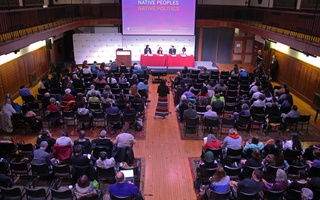Female Native American leaders are prepared to use innovative methods to sustain tribal traditions, said a group of more than 20 female American Indian chiefs who gathered at the Harvard Graduate School of Education yesterday.
The purpose of the Second Annual Leadership Conference of Female Principal Chiefs was to emphasize the special contribution women make in American Indian government, said Bette Haskins, director of the American Indian program at the Ed School.
"Tribal Indian women govern in the old traditional way. You are there to serve others, not for them to serve you," Haskins told the conference participants.
Some chiefs said they were concerned about the way Native Americans are portrayed in the media. Inaccurate portrayals can be a liability to American Indians, they said.
"The media controls the image of the American Indian," said Anita Collins, chair of the Walker River Band of Paiute Indians, Schurz, Nevada. She mentioned that the media exaggerates alcoholism within Native American communities.
The leaders voiced many of the same concerns. Women play a growing role in tribal leadership, they said. The Tonkawa Tribe, represented at the conference by their president Virginia Combrink, made history last year by electing the first all-female government, the chiefs said.
"I had to build up credibility. Some said, 'what are these women going to do?' But we won their trust through hard work," said Collins. Others could not adjust, she said. "Some of the men did not want to work for women, so they left."
At the first event of the conference, the chiefs toured the Hall of the American Indian in the Peabody Museum with Assistant Director of the Museum Ian W. Brown, Peabody Professor of American Archaeology and Ethnology Stephen Williams and Native American artist Joseph Johns.
The Hall of the American Indian has the largest display of Native American artifacts in any university museum, and some of the items on display, especially the pipes, disturbed some of the women.
Collins said she is a Sun Dancer--someone who performs a traditional ritualistic dance and carries a sacred pipe.
"They offended me at Peabody. One of our sacred acts was described as 'self torture.' They don't understand. I guess no one Indian has ever explained it to them. It is so wrong the way the museum projects it," said Collins.
Read more in News
Professors Laud Marshall LegacyRecommended Articles
-
Plaque Good Step Toward InclusionI n an unprecedented move to recognize Harvard's Native American alumni, the College has elected to construct a monument in
-
Native Americans Are Honored With PlaqueCaleb Cheeshahteaumuck, Joel Iacoomes, John Wampus and Eleazer and Benjamin Larnell are hardly household names. But a plaque to commemorate
-
The Invisible MinorityAt Harvard, Erica A. Scott ’06 is far from her extended family. She grew up in Rehoboth, Mass., but most
-
Native Americans Find Campus FamilyIt is April 12, 2005, and about 10 people are gathering in the private dining room of Quincy House for
-
 Forging A Path for Native American Studies
Forging A Path for Native American Studies













